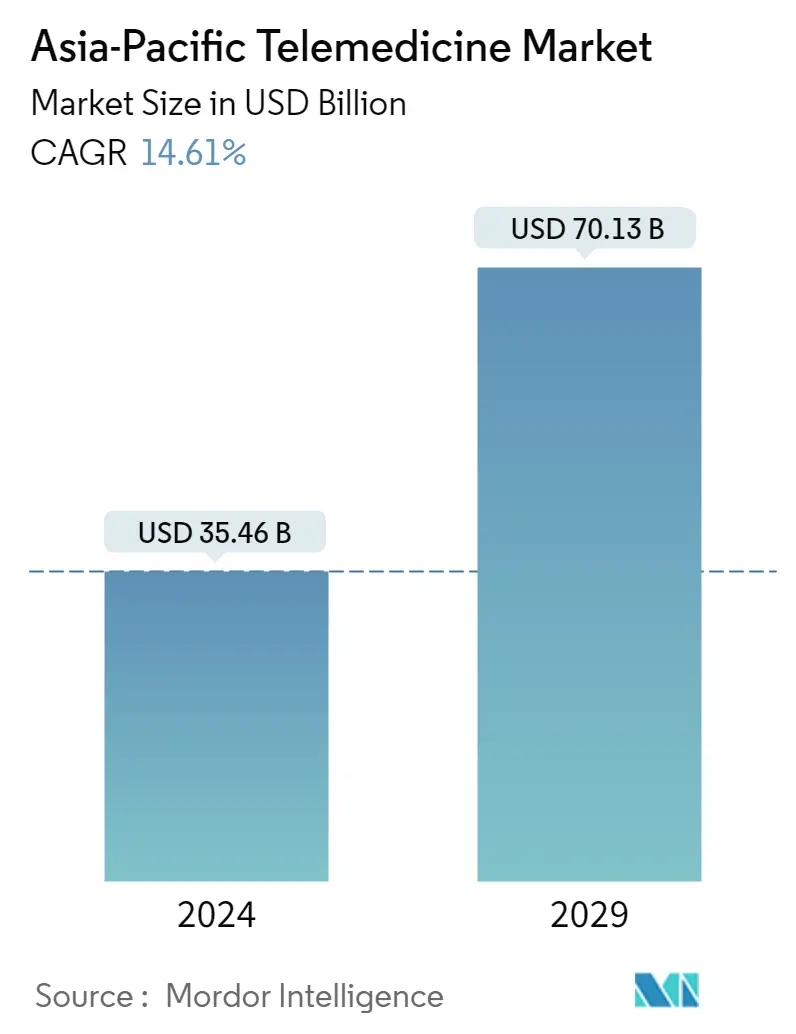Market Size of Asia-Pacific Telemedicine Industry

| Study Period | 2019 - 2029 |
| Base Year For Estimation | 2023 |
| Forecast Data Period | 2024 - 2029 |
| Market Size (2024) | USD 35.46 Billion |
| Market Size (2029) | USD 70.13 Billion |
| CAGR (2024 - 2029) | 14.61 % |
Major Players
*Disclaimer: Major Players sorted in no particular order |
Asia-Pacific Telemedicine Market Analysis
The Asia-Pacific Telemedicine Market size is estimated at USD 35.46 billion in 2024, and is expected to reach USD 70.13 billion by 2029, growing at a CAGR of 14.61% during the forecast period (2024-2029).
Owing to the current Pandemic Situation Asia-Pacific telemedicine is poised to grow owing to the rapid adoption of digital and smart health due to the current social distancing and lockdown protocol in this region. In October 2020, a white paper on technology-led transformation in Indian health care, released by the New Delhi-based Associated Chambers of Commerce and Industry of India stated that rapid migration to digital technologies is marked less by a strategic plan or roadmap and more by the urgency of decision-making due to the pandemic.
Factors such as a rise in healthcare costs, increasing remote patient monitoring, technological innovations, and a growing burden of chronic diseases in the Asia-Pacific region are augmenting the growth of the market.
In October 2020, The Ministry of Civil Affairs in China has predicted that the country's senior population is expected to reach 300 million in five years i.e., between the period 2021-2026, marking a demographic transition to a moderately aging society. And by around 2040, there will be more than 400 million seniors and fewer babies. This has become a serious concern for the Chinese ministry as an upcoming surge in the aging population is expected to increase the burden of various chronic diseases in the country.
With the increasing aging population and prevalence of chronic diseases in the Asia-Pacific region, there is a growing need for finding new ways that increase access to care and reduce the cost of medical care to improve patient outcomes. Using remote patient monitoring, which utilizes devices to remotely collect and direct information to a remote diagnostic testing facility for interpretation, the healthcare providers, insurance payers, and governments are looking to alter the way care is being delivered and at the same time reducing the cost of care. For instance, in November 2019, Royal Melbourne Institute of Technology (RMIT) partnered with the European Connected Health Alliance (ECHAlliance) and launched a digital health ecosystem in Australia to strengthen the connections between patients, clinicians, researchers, policymakers, technology providers, and the community. Therefore, owing to all the above-mentioned factors it is indicated that the telemedicine market will grow exponentially in the Asia-Pacific region.
Asia-Pacific Telemedicine Industry Segmentation
As per the scope of this report, telemedicine services and systems have made the most progress in the remote management of post-acute care patients with chronic conditions. Telemedicine is the remote delivery of healthcare services, such as consultations over telecommunication or teleconference, and it allows healthcare professionals to evaluate, diagnose, and treat patients. The Asia-Pacific Telemedicine Market is segmented By Type (Telehospitals, Telehomes, mHealth ), By Component ((Product (Hardware, Software, and Other Products) and Services (Telepathology, Telecardiology, Teleradiology, Teledermatology, Telepsychiatry, and Other Services)), By Mode of Delivery (On-premise Delivery and Cloud-based Delivery), and Geography (China, Japan, India, Australia, South Korea, and Rest of Asia-Pacific). The market report also covers the estimated market sizes and trends for different countries across major regions in Asia-Pacific. The report offers the value (in USD million) for the above segments.
| By Type | |
| Telehospitals | |
| Telehomes | |
| mHealth (mobile health) |
| By Component | ||||||||
| ||||||||
|
| By Mode of Delivery | |
| On-premise Delivery | |
| Cloud-based Delivery |
| Geography | |
| China | |
| Japan | |
| India | |
| Australia | |
| South Korea | |
| Rest of Asia-Pacific |
Asia-Pacific Telemedicine Market Size Summary
The Asia-Pacific telemedicine market is experiencing significant growth, driven by the rapid adoption of digital health solutions amid the ongoing pandemic. The urgency of transitioning to digital technologies has been accelerated by social distancing measures and lockdowns, prompting healthcare providers to embrace telemedicine as a viable alternative to traditional care. Factors such as rising healthcare costs, technological innovations, and the increasing prevalence of chronic diseases are further propelling market expansion. The aging population in countries like China and the growing burden of chronic conditions necessitate new approaches to healthcare delivery, with remote patient monitoring and mobile health applications playing a crucial role in enhancing access to care and reducing costs.
The market is moderately consolidated, with both large and small players contributing to its dynamics. Technological advancements and product innovations are enabling mid-size to smaller companies to expand their market presence by offering competitive pricing and new services. Key players such as Allscripts Healthcare Solutions, InTouch Technologies, and Aerotel Medical Systems are actively participating in the market, while initiatives like Columbia Asia Hospital's telehealth service and IHH Healthcare's expansion of telemedicine services across multiple countries highlight the growing adoption of these technologies. The integration of mobile health into existing eHealth services, coupled with the expansion of mobile cellular networks, is expected to further boost market growth in the region.
Asia-Pacific Telemedicine Market Size - Table of Contents
-
1. MARKET DYNAMICS
-
1.1 Market Overview
-
1.2 Market Drivers
-
1.2.1 Rising Healthcare Expenditure
-
1.2.2 Technological Innovations
-
1.2.3 Increasing Remote Patient Monitoring
-
1.2.4 Growing Burden of Chronic Diseases
-
-
1.3 Market Restraints
-
1.3.1 Legal and Reimbursement Issues
-
1.3.2 High Initial Capital Requirements and Lack of Physician Support
-
-
1.4 Porter's Five Force Analysis
-
1.4.1 Threat of New Entrants
-
1.4.2 Bargaining Power of Buyers/Consumers
-
1.4.3 Bargaining Power of Suppliers
-
1.4.4 Threat of Substitute Products
-
1.4.5 Intensity of Competitive Rivalry
-
-
-
2. MARKET SEGMENTATION
-
2.1 By Type
-
2.1.1 Telehospitals
-
2.1.2 Telehomes
-
2.1.3 mHealth (mobile health)
-
-
2.2 By Component
-
2.2.1 Products
-
2.2.1.1 Hardware
-
2.2.1.2 Software
-
2.2.1.3 Other Products
-
-
2.2.2 Services
-
2.2.2.1 Telepathology
-
2.2.2.2 Telecardiology
-
2.2.2.3 Teleradiology
-
2.2.2.4 Teledermatology
-
2.2.2.5 Telepsychiatry
-
2.2.2.6 Other Services
-
-
-
2.3 By Mode of Delivery
-
2.3.1 On-premise Delivery
-
2.3.2 Cloud-based Delivery
-
-
2.4 Geography
-
2.4.1 China
-
2.4.2 Japan
-
2.4.3 India
-
2.4.4 Australia
-
2.4.5 South Korea
-
2.4.6 Rest of Asia-Pacific
-
-
Asia-Pacific Telemedicine Market Size FAQs
How big is the Asia-Pacific Telemedicine Market?
The Asia-Pacific Telemedicine Market size is expected to reach USD 35.46 billion in 2024 and grow at a CAGR of 14.61% to reach USD 70.13 billion by 2029.
What is the current Asia-Pacific Telemedicine Market size?
In 2024, the Asia-Pacific Telemedicine Market size is expected to reach USD 35.46 billion.

